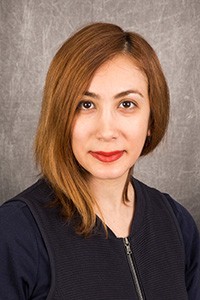
New faculty member working on gene therapies for cancer treatment

Samira Kiani
For the last few years Samira Kiani has been working at the intersection of genome engineering and synthetic biology. Now, as a new faculty member in the Ira A. Fulton Schools of Engineering, she is hoping to further meld those disciplines to develop the next generation of gene therapies in the fight against cancer.
Kiani is an assistant professor of biomedical engineering in the School for Biological and Health Systems Engineering. She comes to ASU from the Center for Synthetic Biology at the Massachusetts Institute of Technology. Originally from Iran, she earned her M.D. from the Tehran University of Medical Sciences.
Kiani joined ASU in January, along with her husband Mo Ebrahimkhani. Ebrahimkhani also joined the faculty of the School for Biological and Health Systems Engineering, as an assistant professor with a focus on synthetic biology and regenerative medicine.
Kiani’s focus has been in the area of gene editing or gene modulation, with a particular concentration on custom DNA binding proteins in human cells. Her focus expanded dramatically with the development of the Clustered Regularly Interspaced short Palindromic Repeats, or CRISPR.
Kiani says the CRIPSR method, developed extensively in the last few years, made the customization of the binding proteins extremely flexible and made the technology of gene manipulation more accessible to labs and researchers around the world.
“I am interested in developing gene editing or gene modulation tools that can specifically act in cancer cells or any cell type of interest,” she said. “It can either lead us to kill cancer cells directly or attract the immune system to these cells so the immune system can recognize these and kill them more effectively.”
One of the keys is that the technology will allow for extreme personalization and precision of gene-based therapies but the tools can also be used for any cell reprogramming purposes.
“Previously, in order to find a treatment for gene therapy, they would put a foreign DNA into the patients body but there were often adverse effects,” she said. “CRISPR allows us to edit the patient’s native DNA for a customized treatment.”
She is hoping to develop partnerships within ASU using the technology as well as partnerships with Mayo Clinic and in other clinical settings.
Kiani says she was drawn to ASU by the interdisciplinary nature of the research and the growing focus on the intersection of medicine and engineering. She also sees a growing community in synthetic biology. She expects the long-term growth in this area at ASU to rival any in the country.
“My background is medicine and I like to develop tools that have therapeutic potential and are based on need,” she said. “I want to be around people who have engineering backgrounds and are able to combine this with their expertise.”
Kiani has expertise in the communication of science, and she hopes to build partnerships within the cancer treatment and research community that will allow her to further public outreach about work in her field.
Her research pursuits are also motivated by a personal experience. In December, as she was making the move to ASU, her father passed away from pancreatic cancer.
“He was battling bravely for the last two years,” she said. “It basically shifted my interest from pure synthetic biology to applying it to cancer. I have seen firsthand how it can affect a patient. So I am not only a scientist, but a patient advocate.”
Kiani said the experience drives her research efforts on a daily basis. She understands the importance of providing the hope of a new discovery to patients and their families, and she wants her students to know her mission and to be aware of the human side of the work they are embarking on.
“I am very interested in helping the students find their motivation,” she said. “I want to be able to transfer to the students that science is not just for the sake of science. There is a lot of need in science. There is need out there, so we must address that need as we tailor our research.”
Written by Gary Campbell



































